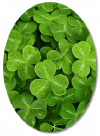|
| |
|
All About Shamrocks
|
 You
have arrived at our Archive Site. We have recently remodeled and if
you click the Home button you will be transported to our new word press
site. If you are on a product page, all the BUY NOW buttons have
been updated to go directly to the new word press product page. Please
update your bookmarks to https://www.celticattic.com You
have arrived at our Archive Site. We have recently remodeled and if
you click the Home button you will be transported to our new word press
site. If you are on a product page, all the BUY NOW buttons have
been updated to go directly to the new word press product page. Please
update your bookmarks to https://www.celticattic.com
|
-
Do you know that there is no such thing
as a "Shamrock Plant"? The word shamrock comes from the
Irish word "seamrog" meaning "little clover".
However, there are hundreds of varieties of clover. The question
is...what is the "Original Irish Shamrock"? Here is what
some respected authorities have to say:
-
"White Clover, Trifolium
repens forma minus, family Leguminosae, was the original shamrock
of Ireland..." Academic American Encyclopedia, Vol. 17, 1990.
-
"In Ireland, the plant most
often referred to as shamrock is the white clover." The World
Book Encyclopedia, Vol. 17, 1993.
-
"Those most commonly called
shamrocks are: the white clover, Trifolium repens, a creeping
white-flowered perennial..." Collier's Encyclopedia, Vol. 20,
1992.
-
"The clovers also occupied a
position in the cultural life of early peoples. White clover (T.
repens L.) in particular was held in high esteem by the early
Celts of Wales as a charm against evil spirits. According to Evans
(1957), this pagen tradition was continued by early Christian
leaders and became the symbol of the Holy Trinity for the Irish
people." Clover Science and Technology, N.L. Taylor, 1985.
-
Saint Patrick used the plant to
illustrate the doctrine of the Holy Trinity. Shamrocks have been
considered by the Irish as good-luck symbols since earliest times, and
this superstition has persisted in modern times among people of many
nationalities. On March 17th, St Patrick's Day is celebrated around
the world, with the "wearin' o' the green".
-
St. Patrick used the Shamrock leaf to
illustrate the mystery of the Holy Trinity, when preaching
Christianity to the Irish people.
-
The word shamrock comes from the Irish
word seamróg or seamair óg, meaning "little clover".
-
The tradition of wearing Shamrock on
Saint Patrick's Day can be traced back to the early 1700s.
-
The shamrock is the most recognizable
emblem of Ireland.
-
For good luck, it's usually included in
the bouquet of an Irish bride, and also in the boutonniere of the
groom.
-
According to Irish folklore, finding a
stem of clover with 4 leaves will bring you good luck, but finding a
clover stem with more than 4 leaves will bring you bad luck.
-
Shamrock Planting and Care:
Shamrocks are a pretty easy plant to grow, thriving in warm to cool
air, fairly moist soil, and in a sunny spot (when they are flowering).
Try not to place them in a south window and don't let them get too
hot, never over 75 degrees.
-
Sow outdoors from March to
September. Sow indoors all year round. When planted in early
January you should have good-sized plants by Saint Patricks Day.
-
Because Shamrocks are bulbs, they
are best planted close to the surface in a peat-based potting
soil. A once per month feeding with a liquid plant fertilizer will
do the trick.
|
|